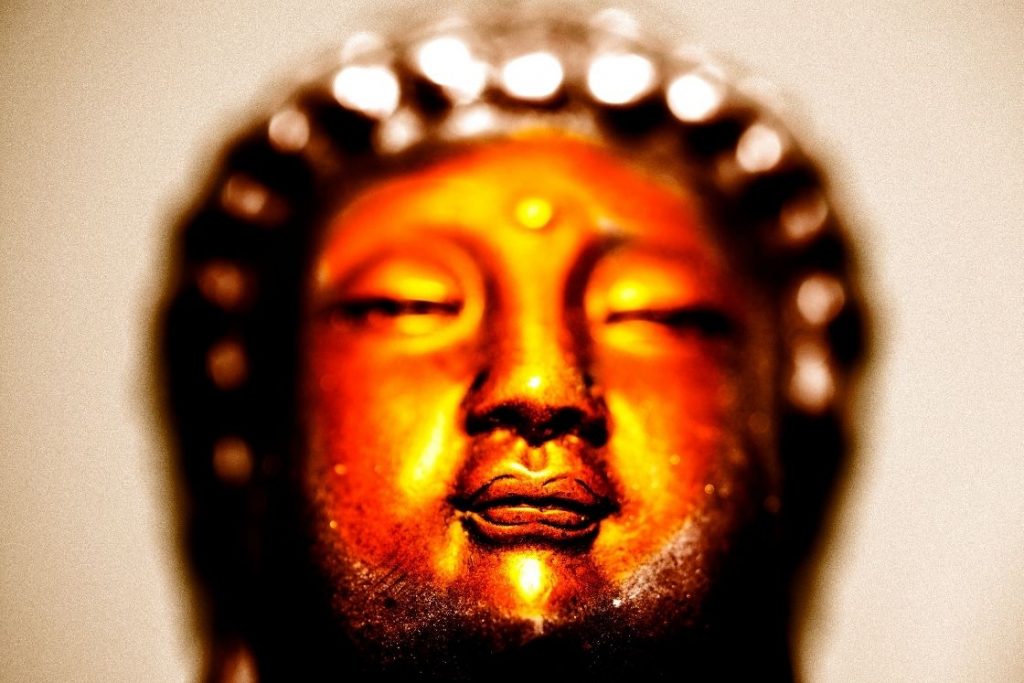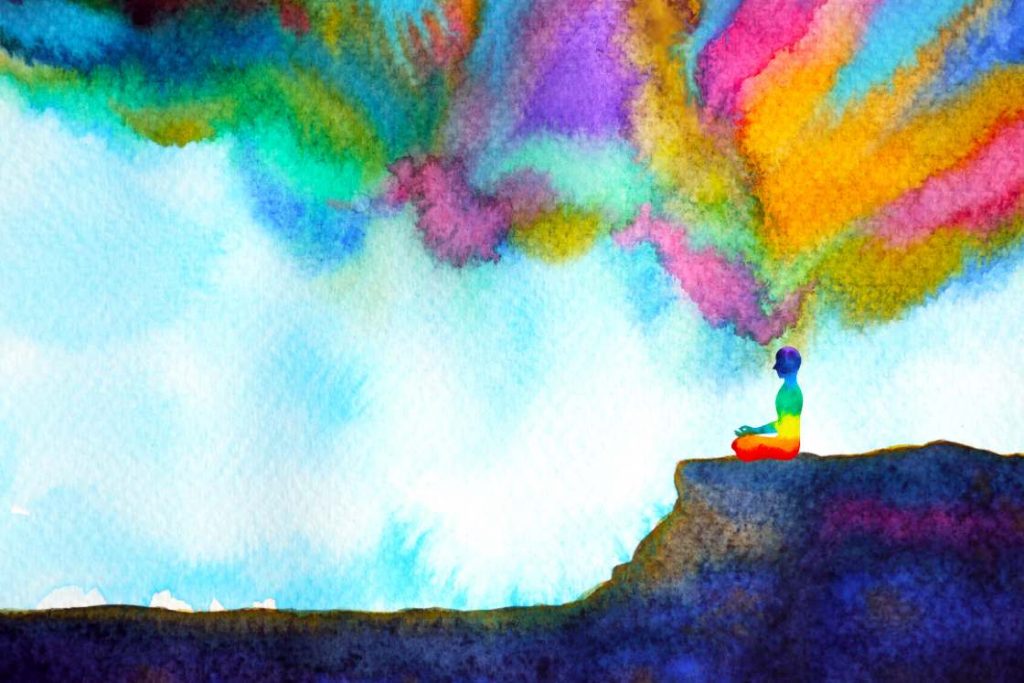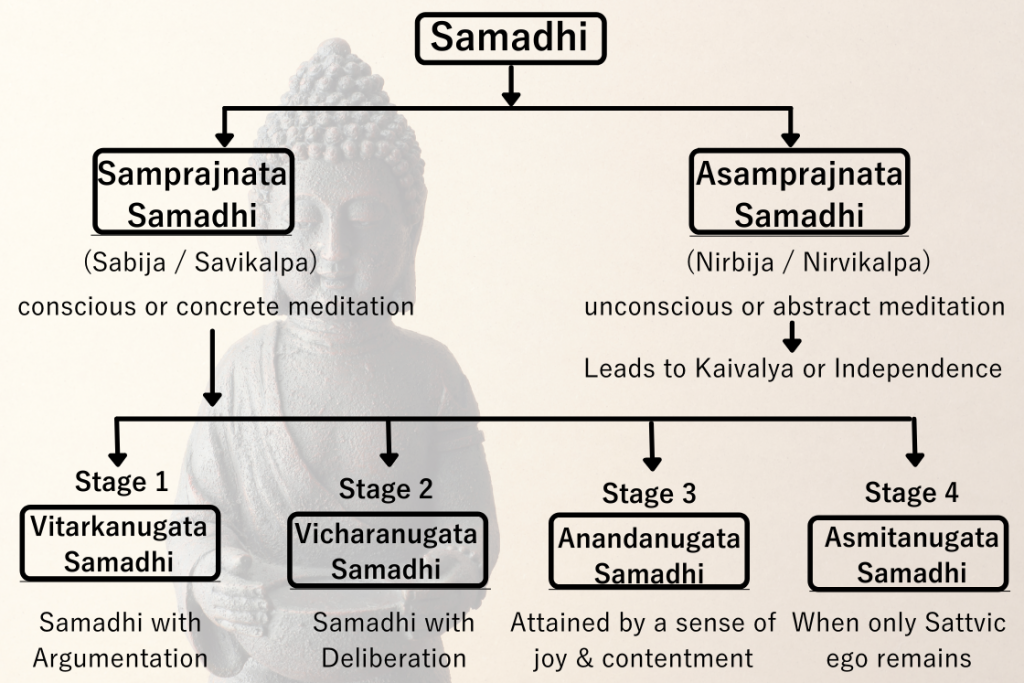- Samadhi Meaning
- What it is?
- Signs of Samadhi state
- 4 Stages
- Samprajnata Samadhi
- Asamprajnata Samadhi
- How to Achieve it?

Our daily lives are full of thoughts, dreams, desires, distractions and sometimes happiness and pain associated with them.
If we observe, it is our consciousness that makes us experience the wide arena of feelings. Sometimes, it is wakeful or sometimes it gives us real life-like experiences while dreaming. The mind is always busy with some, or other thought. This is the major reason why we tend to wrongly associate ourselves with our body or mind.
Yoga philosophy attempts to answer this confusion by offering us an 8-limbed path to self-awareness. Maharshi Patanjali explained in his Yogasutras, the 8 steps to realize Supreme Self.
The last or eighth limb of Yoga is Samadhi. This word is understood mostly in terms of a tombstone or grave. But to understand what the stage of Samadhi actually is, we may have to wander our thoughts around its literal meaning.
The Meaning of Samadhi
Samadhi is made up of two Sanskrit words ‘Sama‘ and ‘Dhi‘ which means ‘equanimous’ and ‘buddhi’ or ‘intellect’ respectively. Thus, the state in which a person brings about equanimity on all levels of their intellect is called Samadhi.
Samadhi can be understood as the state of mind when it is completely absorbed into a thought or in itself so that there is equanimity of “quantity” and “quality” of that thought. When our mind gets complete absorption on a thought, object or idea, even for a short amount of time, it can be said in Samadhi.
Another meaning of the word Samadhi is ‘completion’. Just like a problem is said to finish only when we get its “solution”, Samadhi is translated as full completion of a thought. Therefore, a person who reaches the completion of the understanding of his true self is said to have achieved the state of Samadhi.
One more meaning of the word Samadhi is ‘to bring together.’ Thus, the state in which the subject (meditator), the object of meditation and knowledge of the object get together to form a union, is a state of Samadhi. Here, the person who is meditating unites with the process of meditation itself, remaining no individual but becoming one with the source of the entire universe.
So what exactly is Samadhi?
Samadhi is the ultimate state of yoga where yogi unites with supreme self by eliminating all mental modifications (Chitta vrittis). It can be said the state of thoughtlessness, oneness or ultimate bliss.
In samadhi, awareness of the subject-object distinction gets eliminated, so only remains the pure consciousness. According to Patanjali Yoga Sutra 1.14, when the effort to remain in the state of pure consciousness ceases, then the Samadhi occurs, in which the mind is completely absorbed in the Self.
There are 7 steps one needs to master before achieving the samadhi.
- Yam (Observances)
- Niyama (Abstinences)
- Asana (Postures)
- Pranayam (Breath controlling)
- Pratyahara (Withdrawal of senses)
- Dharana (Determination)
- Dhyana (Meditation)
- Samadhi (Self-realization or Nirvana per Buddhist philosophy).
What does the state of Samadhi feel like?

The Samadhi state is characterized by the silence of the mind, absorption of individuality into the Supreme Consciousness, the realization of the higher identity, and union with it.
From these characteristics only, we can infer that achieving Samadhi state is not an easy task. It does not come to us by accident or luck. The Yogis have to put effort and dedication into it. This is the reason why it is probably the last stage of Yoga. Like all the other limbs of Yoga, Samadhi also needs a lot of contemplation and practice.
As the Yogis move forward on the path of Yogabhyasa (study of Yoga), when they have gotten rid of all the desires, distractions, and become purely Sattvic (balanced), their wish to go closer to the Supreme-self increases. Thus, after the intense practice of dharana and dhyana, the Samadhi state unfolds. In this, the yogi feels no distractions of the mind whatsoever. He becomes one with the greater identity that is the Supreme self or Bharhman.
The yogi entirely loses his association with the material world and connects himself with the inner self. Samadhi state is called the state of realization for this. When there is no meaning to anything else but only Brahman. The Yogi will be immersed in the source of all the knowledge, universe, and existence. He will know that the body and possessions are false, the mind is false, only which is true is the Brahman or the Supreme Consciousness.
There is no perception of time or space in the state of Samadhi. The person is absolutely one with the Supreme self and has lost material awareness. However, losing material awareness does not mean that person is incapable of using his consciousness or intellect. He has only transcended all these abilities to stay in the phase of pure bliss.
Stages of Samadhi

Based on different practices to attain Samadhi until the liberated state, or kaivalya, finally appears, it can be categorised mainly into two types. First yogis attain the Samprajnata Samadhi and then with more deep meditation comes Asamprajnata Samadhi.
Maharshi Patanjali says that the workings of the mind – the Chitta vrittis- are the obstacles in the Yogic path to liberation. These 5 vrittis are to be eliminated if the person wants to achieve the Ultimate Truth.
How to go about negating these disturbing workings of the mind and be in the Samadhi state for a long time? The process is stepwise, as any difficult mathematical equation would go. For this, Patanjali has explained the stages of the Samadhi.
There are four stages of samadhi. It is the one that accompanies vitarka samadhi (reasoning), vichara samadhi (reflection), sananda samadhi (ecstasy), and asmita samadhi (realization of the self). When the person is able to feel all of the above, he is said to be in the highest state of Samprajnata Samadhi.
1. Samprajnata Samadhi
This is the first level of Samadhi as it involves not getting shattered by the experiences around us, but following the concrete meditation accompanied by argumentation, deliberation, happiness, and sattvic egoism. It’s not a permanent state and everybody has to return to ordinary consciousness from this samadhi.
Samprajnata samadhi is that in which yogi takes the support of a gross physical object, idea or thought to meditate upon. With the help of this support, the yogi gets psychic powers (Siddhis) and full knowledge of that object.
In this state of Samadhi, the yogi is involved in the tapas but still available to the world. That means, he is aware of his surroundings and can feel the big changes that are happening outside around him. But he uses his knowledge to differentiate between the outside and inside and hence achieves the state of Samprajnata samadhi without getting disturbed by the trivial changes. The yogi does not respond to the outside events even though he is aware of them.
Samprajnata is also called Sabija samadhi as in it Samskaras (past seeds of karma) are not destroyed. In some way or other, we are still entangled in the bondage of karma even when in this samadhi. Vedantins call it Savikalpa samadhi.
#stage 1. Savitarka and Nirvitarka Samadhi
Tarka refers to our ability to reason. Savitarka is the stage of Samadhi that offers advantageous reasoning to our minds and is accompanied by argumentation.
However, it is the stage of struggle, where the person is connected to the physical world yet wants to reach the world of the Ultimate. But as the sadhana of the yogi progresses, this internal struggle is overcome and the yogi is ready to reach the world of the Supreme Consciousness.
Beyond the savitarka, is the nirvitarka- a further higher stage of samadhi, in which the person loses his touch with the physical sense of space and time and understands the existence of the universe in itself. The yogi has transcended the state of awareness of the universe. He is now in the phase where he is a part of the universe.
#stage 2. Savichara and Nirvichara Samadhi
Savichara is the higher experience, in which the yogi is capable of bringing thoughts but his mind is extremely quiet. He communicates with the large universe but understands its operations still through space and time. The yogi knows that he is a form of energy who is meditating on a bigger form of energy that is there in the form of Supreme Consciousness.
One step higher is the nirvichara samadhi, in which there is no difference between the two energies. The yogi realizes that he is not anymore, the energy meditating on the higher consciousness, but he is that consciousness himself. He has completely lost in space and time and is united with the Supreme.
#stage 3. Sananda Samadhi
The next stage of the Samadhi is where the Yogi’s thoughts are absolutely balanced. Every aspect of his system flows in balance. The flow of Prana balances its way and now flows in the Sushumna Nadi. When all the systems are in perfect equilibrium (Samatva as mentioned in Bhagavad Gita) the Yogi comes to a blissful state.
This happy stage is called the Sananda Samadhi. In here, the person’s mind is empty, thoughtless, but only one feeling accompanies him. It is the feeling of bliss.
#stage 4. Asmita Samadhi
When the yogi elevates to the next level, a level beyond bliss, he reaches a stage where there is no sense of ego or identity. That I-ness is merged with the universe and what remains is only the reflection of the all-pervading consciousness.
The Sasmita Samadhi stage involves the feeling of I-ness which is the same as the universe. When the yogi stabilizes in this stage and meditates further, more subtle aspects of the universe will be felt. And upon passing them, he is said to have attained Moksha.
2. Asamprajnata Samadhi
This is the second level of the Samadhi state. It’s called abstract meditation as there is no object or thought to meditate upon.
In Asamprajnata Samadhi, the Yogi becomes fully pure, desireless, and has gotten rid of all the attachments of the material world. He is absolutely immersed in the world beyond the physical, where the journey starts toward self-realization.
Any outside interference would not matter and the Yogi will not respond to any outer influence. He goes deeper into the meditation until the moment comes where everything else loses meaning and only the Supreme identity remains.
How to achieve Samadhi?

One might wonder if the state of Samadhi is relevant in daily life. It is possible to achieve the samadhi state and stay in for some time even amidst our daily actions. The realization of our pure existence is possible as we meditate daily, elevating ourselves step by step on the path of Kaivalya.
According to Vyasa commentary on Yoga Sutra 1.1, Yoga is Samadhi. And Samadhi is said to lie in all 5 states of mind (Chitta). It means even in our day to day life, when we are not aware at all, we can be said in Samadhi for a small fraction of time. But in yogic language, Samadhi is called only when the mind happens in the last two higher states; Ekagra (one-pointed) and Niruddha (fully concentrated).
There are certain moments of concentration that occur in our daily lives where we are completely engrossed in the task, forgetting everything around us. In such a situation, we are completely absorbed in the task we are doing. For example, a painter might forget her immediate physical world while drawing a fine stroke.
Initially, there may be some struggle to do the good stroke as in the first stage savitarka samadhi. But as she gains control over that using her intellect, the painter is uplifted to the next nirvitarka state. In this, she is so immersed in the painting that she becomes part of the task herself.
While elevating to the next stage, the savichara state, the painter is able to communicate with her object of meditation. She is able to understand every way through which the painting is done, she understands her universe while staying conscious. Next, in the nirvichara state, she matches her energy with that of the universe and is fully in the state of thoughtlessness.
The routine tasks that we do involve a lot of thinking, decision making, and imagination. When we clear our mind through yoga and meditation, all the unnecessary or unreal pressure in the head, we clear our way to a higher and longer state of samadhi.
Final thought
The state of Samadhi is explained by various terms in the Indian scriptures. What Patanjali calls Samadhi or Kaivalya is termed Nirvana by Buddha. All these conditions essentially convey the same state of thoughtlessness, desirelessness, and non-attachment.
The stage of samadhi is very difficult to achieve. Maharshi Patanjali says two practices can elevate the meditator on the Yogic path- Abhyasa (self-study) and Vairagya (non-attachment). The consistent practice of these two can result in the realization of higher stages and the yogi can reach the Samadhi state.
When we get rid of the physical pleasures, desires and move forward toward understanding our own self, we move closer to forming the connection with the greater identity. Sometimes, the material objects, feelings, our chitta vrittis can take us back, deteriorating our progress to achieve samadhi. But that is why abhyasa and vairagya are explained by Sage Patanjali.
The union with the Supreme self is a long journey. It is possible if we stay committed to our Yogic sadhana. Wish you all the best for this fulfilling journey to finding your Swaroopa!




